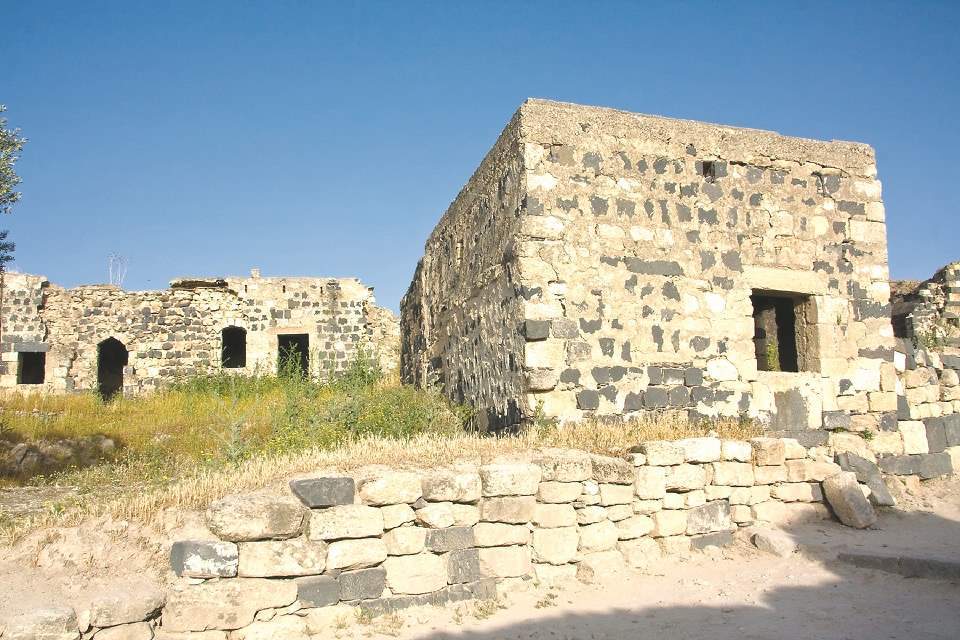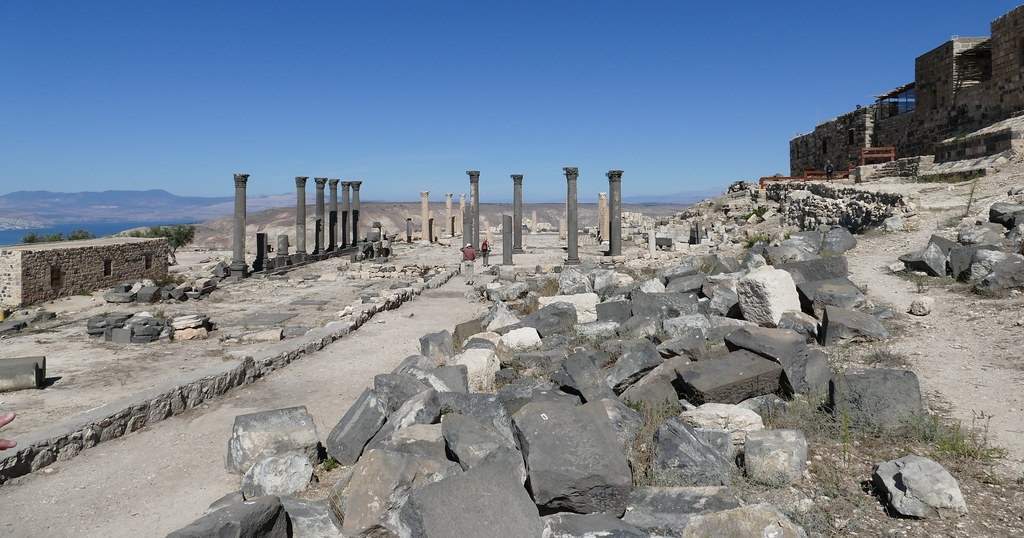AMMAN — Umm Qais is an ancient city located 110km northwest of the capital and one of the main tourist attractions in Jordan.
Best known for its Roman-era basalt theaters, columns, and streets.
اضافة اعلان
Umm Qais is located on a plateau, 378m above sea level, in the far northwest corner of the
Kingdom, and offers panoramic views of three neighboring countries.
It also overlooks Lake Tiberias, the Golan Heights, the Jordan River, the Yarmouk River, Jabal Al-Sheikh, and Mount Tabour.
The site was home to several civilizations, including prehistoric cultures; some of these cultures include the Greeks, Romans, Byzantines, early Muslims, and Ottomans.
Umm Qais was previously called Gadara or Gadar, which, according to
UNESCO, derives from a Semitic term meaning “fortification,” which stems from a pre-Hellenistic stronghold that secured this stretch of land between southern
Syria and the north
Palestine coastal ports.
 Umm Qais, one of the main tourist attractions in Jordan. (Photo: Wikimedia Commons)
Umm Qais, one of the main tourist attractions in Jordan. (Photo: Wikimedia Commons)
The name changed from Gadar/Gadara to Umm Qais in the Middle Ages. Umm Qais (from mkeis, the early Arabic “frontier station”) reflected the settlement’s ancient role as a border post.
However, Jordanians widely agreed that the name Mkeis came from the city’s role as a tax-collection center during the Ottoman era as “mukoos” means taxes.
Historically, Gadara was a member city of the Decapolis (ten cities in
Greek) that comprised the southeastern frontiers of the Roman Empire.
The Decapolis is the geographical region that included 10 cities that shared language, culture, and political status.
They flourished under the Romans from 63 BC to 324 AD.
Six of these city-state settlements were in Jordan, three in Syria, and one in Israel. Jordan had Gerasa (Jerash), Capitolias (Beit Ras), Gadara (Umm Qais), Philadelphia (modern day Amman), Abila, and Pella.
Umm Qais was established as a Hellenistic military colony by the generals of Alexander the Great in the third century BC.
In the Greek era, Gadara was a strategic location during the wars between the Ptolemys, whose mainland was
Egypt, and the Seleucids, who were based in Antioch.
During the Roman-Seleucid wars, the Seleucids lost control of the Levant, allowing locals to become more powerful.
The Hasmonean King Alexander Jannaeus took Gadara and was able to control the trade of the Nabataeans that came from Bosra to the Mediterranean. However, the Nabataeans, led by their King Obodos I, defeated him in the Battle of Gadara in 93 BC.
Roman rule
Led by General Pompey, the Romans arrived in the region in 63 BC.
They took control of all Hellenistic settlements in northern Jordan, including Umm Qais, which started minting its own coins and adopted the Pompeian calendar.
It is said that Pompey gave special attention to Umm Qais because it was the birthplace of one of his favorite freedmen, Demetrius the Gadarene.
Umm Qais was also located on the main road that came from Philadelphia and Gerasa to Pella and Scythopolis (Beitshan), which was a branch coming from the main regional road known as Via Triajana Nova (the new road of Trajan) that connected Aqaba in the very south of Jordan to Bostra in Syria and was based mainly on the biblical King’s Highway.
During the Roman era, Umm Qais saw its golden age as an autonomous city-state that provided luxurious life to its citizens, evident from its infrastructure and facilities.
Philosophers and poets
Beyond the rich geographical history, Umm Qais was famous for housing poets and philosophers. For example, Oenomaus of Gadara, a Cynic philosopher, known principally by historians for his long extracts of work attacking oracles, was an Umm Qais native.
Cynicism is a school of thought that invites people to live a life with virtue closer to nature and refuse to surrender to the desires of wealth, power, and fame.
In Umm Qais was also Arabius, a famous poet known for his tomb inscription that says: “Oh passerby: As you are now, I used to be, and as I am now, you will be, enjoy life as you are mortal.”
Menippus of Gadara, who founded the Menippean satire genre, was also an Umm Qais local. The Menippean satire genre mocks ideas, beliefs, and institutions using prose and verse.
Visiting today
Visiting Umm Qais today, you can find the remains of primarily Roman monuments as the city’s central infrastructure was rebuilt during this era.
Umm Qais witnessed major rebuilding during the Roman era using the Hippodamian Plan, a city planning system based on a grid of streets intersecting on right angels, created by Greek Architect Hippodamus of Miletus.
The main venue in Umm Qais is called the Decumanus Maximus, an east-west colonnaded street that passes through the whole city and is surrounded by shops and public buildings.
The Decumanus Maximus once linked Umm Qais with nearby ancient cities such as Abila and Pella.
Among the distinctive monuments in Umm Qais are the two well-preserved theaters, which are both made of black basaltic stones quarried from a nearby volcanic area.
The western theater is the only theater in Jordan that faces west (the rest face the north) and doesn’t have a back-stage structure, for it was used by people who came to the theater after taking a bath at the nearby hot springs Himma.
You can also find the longest subterranean aqueduct (artificial watercourse) in Umm Qais, stretching 170km from Jordan to Syria — more than nine times the length of the second-longest subterranean aqueduct in Italy.
The value of the city is beyond its physical attributes, as it was also mentioned in the New Testament several times for its proximity to Lake Tiberias and other holy sites visited by Jesus Christ and for being mentioned in the Bible as the location of the miracle of the Gadarene Swine.
 The octagonal church, a Byzantine-era monument, was built in the early 6th century. (Photo: Flickr)
The octagonal church, a Byzantine-era monument, was built in the early 6th century. (Photo: Flickr)
Beyond the remaining Roman Architecture, you can also find historical monuments from 324–636 AD Byzantine era. Among the Byzantine-era monuments is the octagonal church which was built in the early 6th century.
In 636 AD, Umm Qais witnessed a key battle that took place near that adjacent Yarmouk River, ending the Roman existence in Jordan.
Not much is mentioned about Umm Qais in Muslim history until the Ottoman era when Umm Qais reappeared as a center for collecting taxes.
In recent history, Umm Qais hosted a conference discussing the division of the Arab World by the allies after World War I in the early 20th century. This conference was held at the Rousan house, which currently serves as a museum.
To best enjoy Umm Qais, make sure to visit in spring, where you can enjoy the green landscape, moderate temperatures, and clear views.
Beyond the historical architecture, the literary significance, and the museums, you can also enjoy the rest house, which provides food and beverages with an overlook.
Read more Lifestyle



